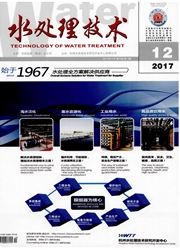

 中文摘要:
中文摘要:
对以煤基微孔碳管为组件的碳膜曝气膜生物反应器(MABR)处理高浓度氨氮污水进行了实验研究。碳膜同时起到生物膜载体和无泡曝气的双重作用。氧气和营养物分别从生物膜的两侧进入膜内。本实验进行150d,分阶段对不同溶解氧(DO)条件,不同进水浓废和不同水力停留时间(HRT)下,MABR的硝化,瓦硝化同时去除COD的性能进行研究。研究表明,在溶解氧为0.8mg/L的条件下,TN有最佳去除效果,NH3-N、TN和COD去除率分别为87.88%、86.5%和87.64%。NH3-N的去除率随DO的升高而增大,去除率可达99.7%,但更高的溶解氧(〉1.6mg/L)对去除率影响甚微。高进水负荷实验于16d内,进水NH3-N浓度增大4倍,至214.25mg/L,去除率仍保持92%以上。HRT由20h逐渐降低至8h时,去除率略有降低,但去除负荷增长2倍以上。说明该MABR装置有良好的脱氮能力和较高负荷下的污水处理能力。
 英文摘要:
英文摘要:
The treatment of high concentration ammonia wastewater by a membrane aeration biological reactor (MABR) made of coal-based carbon tube membrane was studied in laboratory scale. The carbon membrane was acted as biofilm carrier and bubbleless aeration device at the same time. Nutrient substances and oxygen entered into the membrane from opposite side of membrane. The experiment was carried out for 150 days to study nitrification, derdtrification and aimultaneous carbon removal performance of MABR under the conditions of different dissolved oxygen (DO) concentration, diffont hydraulic retention time (HRT), and different hydraulic loading rates. The study showed that total nitrogen(TN) had the optimal removal rate when dissolved oxygen(DO) was 0.8 mg/L, and the removal rates of NH3-N, TN and COD were 87.88% ,86.5% and 87.64% respectively. The removal rate of NH3-N was enhanced with DO rising and the could reach to 99.7%. But it did little effects when DO was over 2 mg/L. The experiment was carried out for 16 days with the concentration ofinfluent NH3-N raised by 4 times and reached to 214 mg/L, the removal rate could still keep over than 92%;. When hydraulic reparation t/me reduced to 8h from 20h, the removal rate reduced slightly, but the removal loading doubled. The results suggested MABR had good capability in nitrogen removal and excellent performance of high loading rates.
 同期刊论文项目
同期刊论文项目
 同项目期刊论文
同项目期刊论文
 期刊信息
期刊信息
